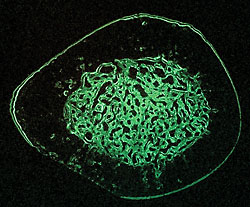 | In the new minimally invasive technique, bone marrow and hormone injections are combined to create new bone that appears structurally and biologically normal. |
A new technique that combines bone marrow removal and injection of a hormone helps promote rapid formation of
new bone at targeted locations in the body, it was reported by researchers
at the Yale School of Medicine in the February issue of the journal Tissue
Engineering. — By Jacqueline Weaver
T H I S
Yale scientists develop technique for creating new bone that could radically
change how fractures are treated
“This could radically change the way patients are currently treated for
weakened or fractured hips, vertebrae and acute traumatic long bone fractures,” says
senior author Agnès Vignery, associate professor of orthopedics.
Currently available treatment requires surgery and artificial materials and
often results in imperfect outcomes, says Vignery, adding, “The ideal
approach would be to create new bone where it is needed and at a faster rate.”
The study in mice was done in collaboration with Unigene Laboratories Inc.
It evaluated the effect of bone marrow removal from particular sites followed
by daily injections of anabolic agents such as parathyroid hormone (PTH).
The procedure creates new bone tissue that appears structurally and biologically
normal and that endows the targeted bone with improved biomechanical properties
at a rate and extent that would not be achievable by anabolic therapy alone,
Vignery says.
“We have shown that it is the synergistic effect of mechanical marrow ablation
and PTH that allows for this new bone to fill the marrow cavity,” she says.
Vignery notes that additional studies are underway that extend the results
of this work in other animals and that will determine whether the newly formed
bone can be preserved over a long period of time.
Co-authors include Qing Zhang, Estaban Cuartas, W. Mark Saltzman, Maya Kotas,
Mandy Ma, Sonali Rajan, Cécile Chalouni and Jodi Carlson, of Yale, as
well as Nozer Mehta, James Gilligan and Hua-Zhu Ke.
 W E E K ' S
W E E K ' S S T O R I E S
S T O R I E S![]()
 Study Group releases report on feasibility of adding . . .
Study Group releases report on feasibility of adding . . .![]()
![]()
 Yale-developed test 99% accurate in detecting early ovarian cancer
Yale-developed test 99% accurate in detecting early ovarian cancer![]()
![]()
 SOM broadens international offerings
SOM broadens international offerings![]()
![]()
 Law student launches fundraising effort for Rwanda's first public library
Law student launches fundraising effort for Rwanda's first public library![]()
![]()
 Hines Fund will promote sustainable architectural design
Hines Fund will promote sustainable architectural design![]()
![]()
 Grant to expand study of how plant proteins function
Grant to expand study of how plant proteins function![]()
![]()
 Yale scientists develop technique for creating new bone that . . .
Yale scientists develop technique for creating new bone that . . .![]()
![]()
 Dean Grey cited for ‘landmark’ nursing research
Dean Grey cited for ‘landmark’ nursing research![]()
![]()
 ‘Renewing Hope’ to explore alliance of religion and ecology
‘Renewing Hope’ to explore alliance of religion and ecology![]()
![]()
 Expatriate couple’s influence recalled in ‘Making It New’
Expatriate couple’s influence recalled in ‘Making It New’![]()
![]()
 Conference will explore writer’s life and work before and after . . .
Conference will explore writer’s life and work before and after . . .![]()
![]()
 Student-run conference to examine innovative approaches to . . .
Student-run conference to examine innovative approaches to . . .![]()
![]()
 Young Scholars Conference to feature papers on ‘cutting-edge’ . . .
Young Scholars Conference to feature papers on ‘cutting-edge’ . . .![]()
![]()
 Sterling Library show offers proof that ‘Art Is Where You Find It’
Sterling Library show offers proof that ‘Art Is Where You Find It’![]()
![]()
 Yale Cabaret benefit explores experience of American veterans . . .
Yale Cabaret benefit explores experience of American veterans . . .![]()
![]()
 Make that four
Make that four![]()
![]()
 Award-winning Yale building design projects are highlighted . . .
Award-winning Yale building design projects are highlighted . . .![]()
![]()
 Workshop to host talk on ‘Flight from Arbitration’
Workshop to host talk on ‘Flight from Arbitration’![]()
Bulletin Home |
| Visiting on Campus
Visiting on Campus |
| Calendar of Events
Calendar of Events |
| In the News
In the News![]()
Bulletin Board |
| Classified Ads
Classified Ads |
| Search Archives
Search Archives |
| Deadlines
Deadlines![]()
Bulletin Staff |
| Public Affairs
Public Affairs |
| News Releases
News Releases |
| E-Mail Us
E-Mail Us |
| Yale Home
Yale Home